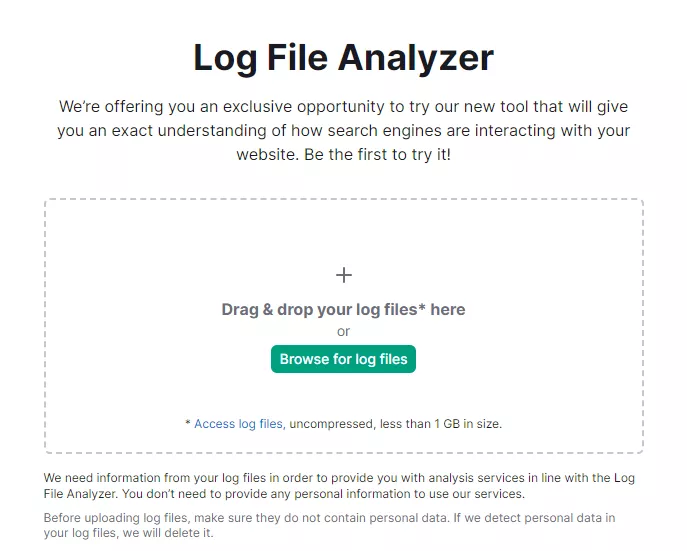What is a Log File Analyzer?
A Log File Analyzer is like a detective for website information. Websites keep track of everything that happens on them, just like you might keep a diary. This information is stored in special files called log files.
A Log File Analyzer can take a look at these log files and understand what they mean. It can tell you things like:
What pages people visit on your website
What people try to do on your website, like searching or buying something
If any problems are happening on your website, like error messages
How Does It Work?
Here are the steps involved in how a website log file analyzer works:
Data extraction: The log file analyzer first extracts information from the website's log files. These log files record details about every visit, IP addresses, request methods, HTTP status codes, user agents, referrers, and bytes transferred.
Data normalization: The extracted log data may have inconsistencies or errors that need to be normalized. This involves organizing the data and cleaning it up. This cleanup process makes sure the analytics are based on consistent and reliable data.
Data analysis: Once the data is cleaned up and standardized, the log analyzer can accurately analyze patterns and trends in website traffic, user behaviour, and server performance. This can include identifying the most frequently accessed pages and resources, the most popular user agents and referrers, and any errors or issues that are occurring on the website.
Reporting: The log analyzer compiles all the key findings into reports. These reports summarize the statistics and insights with visualizations like graphs and charts. The reports provide actionable and easy-to-understand website analytics and recommendations to optimize website performance, improve security, and enhance the user experience.
What Data Does a Log File Contain?
The data contained in a website log file typically includes:
IP address: The IP address of the device that requested the server.
Timestamp: The date and time that the request was made.
Request method: The type of request made, such as GET, POST, or PUT.
Requested resource: The specific file or resource that was requested, such as a webpage or image.
HTTP status code: The status code returned by the server in response to the request, such as 200 for a successful request or 404 for a file not found error.
User-agent: Information about the browser or client making the request, including the name and version of the software.
Referrer: The URL of the webpage that referred the user to the requested resource, if applicable.
Bytes transferred: The size of the data transferred in response to the request.
Website log files can also contain additional information, depending on the server configuration and the logging settings.
Why Should You Use Log File Analyzer?
Here are a few reasons why you should use the log file analyzer tool:
Identify website issues
A key use of the website log file analyzer is to identify technical problems happening on a website. By processing the log files containing records of all visitor activity, the analyzer can spot issues like:
Traffic drops
Server errors
The analyzer makes these website issues clearly visible. This allows the website owner to pinpoint and troubleshoot the root causes. Fixing these problems can improve visitor experience and retention.
Optimize website performance
The log file analyzer provides key insights to help optimize website performance and speed. By revealing the most frequently accessed pages and visitor devices, web developers can better understand usage.
This information can be used to optimize your website's content and structure to better meet the needs of your users and improve their experience.
Monitor website security
This tool can help you monitor website security by identifying suspicious activity, such as attempts to access sensitive files or inject malicious code.
This can help you take preventative measures to protect your website from attacks and keep your users' data safe.
Improve SEO performance
Website log file analyzer can provide valuable insights into how search engines are crawling your website, including the frequency of crawls, the pages that are being crawled most frequently, and the pages that are returning errors.
This information can be used to optimize your website's crawl budget and improve its search engine rankings.
Why is Log File Analysis Used For SEO?
Log File Analysis is useful for SEO in the following ways:
Crawl budget optimization
Search engine crawlers can only crawl a limited number of web pages on each website. Looking at log files shows which pages on your site get crawled the most, and which don't get crawled much.
Using this information, webmasters can optimize their sites. This involves making changes so search engines will crawl the most important pages within their crawl budget.
Identifying crawl errors
It also helps you identify crawl errors that may be impacting your website's search engine visibility.
By analyzing the log files, you can identify pages that are returning errors, such as 404 Not Found errors or 500 Internal Server Errors.
This can help you quickly identify and resolve issues that are preventing search engine crawlers or users from accessing your content.
Understanding user behavior
Looking at log files shows how people use websites. The logs provide information on which pages users visit.
This helps website owners better understand what visitors want. Owners can use the insights to improve their website content and design. This enhancement helps give users what they're looking for. It can also help the website rank better in search engines.
The goal is to analyze user behaviour from log data. Then make changes so the website works better for visitors.
Monitoring bot activity
Looking at log files shows the activity of bots on a website. For example, it can reveal when search engine bots crawl the site and how often.
This information can help webmasters optimize their websites. They can use it to ensure search engine bots can easily and efficiently access content on the site.
How to Perform Log File Analysis?
Log file analysis can be broken down into two steps:
Collecting log files
Analyzing log files using a tool
Collecting log files
To get your log file, you will need to access the server or hosting platform where your website is hosted. Here are a few ways to get your log file:
Access the log file on your server
If a website is hosted on a dedicated or virtual private server (VPS), the log files are stored directly on that server.
Website owners can get the log files in three main ways:
SSH connection - A secure remote login to the server
FTP connection - Transfer files from the server over the internet
Control panel - A web interface by the hosting provider to manage files
So with a dedicated or VPS website host, there are direct server access options to retrieve log files for analysis.
Use a web-based control panel
Many hosting providers offer a web-based control panel that allows you to access and download your log file.
The location of the log file may vary depending on the hosting provider, but it is often located in a directory called "logs".
If you are using a cPanel, follow these steps:
Log in to your cPanel account.
Navigate to the "Metrics" section and click on "Raw Access".
Select the domain you want to analyze from the dropdown menu.
Choose the time you want to analyze from the "Timeframe" dropdown menu.
Click on "Download" to download the log file in a compressed format.
Extract the compressed file to access the log file. The log file will typically be in a format such as "access_log".
Use a third-party service
There are also third-party services available that can help you collect and analyze your log files. To do this, website owners allow access in two main ways:
SSH connection - The company connects securely to the server to get the log files
File uploads - The website owner uploads log files to the analysis company's platform
Analysing log files using a tool
Several tools can be used for log file analysis but the most common ones are Semrush and Screaming Frog.
Using Semrush

To perform a Log File Analysis using Semrush, follow these steps:
Go to Semrush and log into your account.
Navigate to "Log File Analyzer" under "SEO Toolkit."
Upload your website log files to Semrush. You can upload a file directly or connect to a cloud storage service like Google Drive or Dropbox.
Configure your analysis settings - choose date range, timezone, user agent to analyze, etc.
Run the log file analysis. This may take some time depending on file size.
Review the analysis dashboard when complete. It shows metrics like the number of crawls by search engine bots, most frequently crawled pages or pages with errors
Use the insights to optimize your website SEO.
Using Screaming Frog
To perform a Log File Analysis using Screaming Frog, follow these steps:
Open Screaming Frog and go to "Log File Analyzer"
Click "New" to create a new log analysis project
Enter your log file locations and set analysis settings like date range, user agent, timezone
Click "Start" to run the log file analysis. This may take some time.
Review analysis dashboard for metrics like search engine crawl stats, most visited pages, pages with errors
Use the insights to optimize SEO. For example, improve the crawl budget, fix crawl errors, identify important pages, etc
Takeaway
The Log File Analyzer tool is very useful for website owners, developers and SEO experts. It gives insights into website activity, user behaviour, and server performance.
Analyzing log files helps to:
Find issues on a website
Optimize website speed
Monitor security
Improve SEO
The insights allow owners to better meet visitor needs. They help create a better user experience. In short, log file analysis helps optimize sites in key areas like security, speed and SEO.


